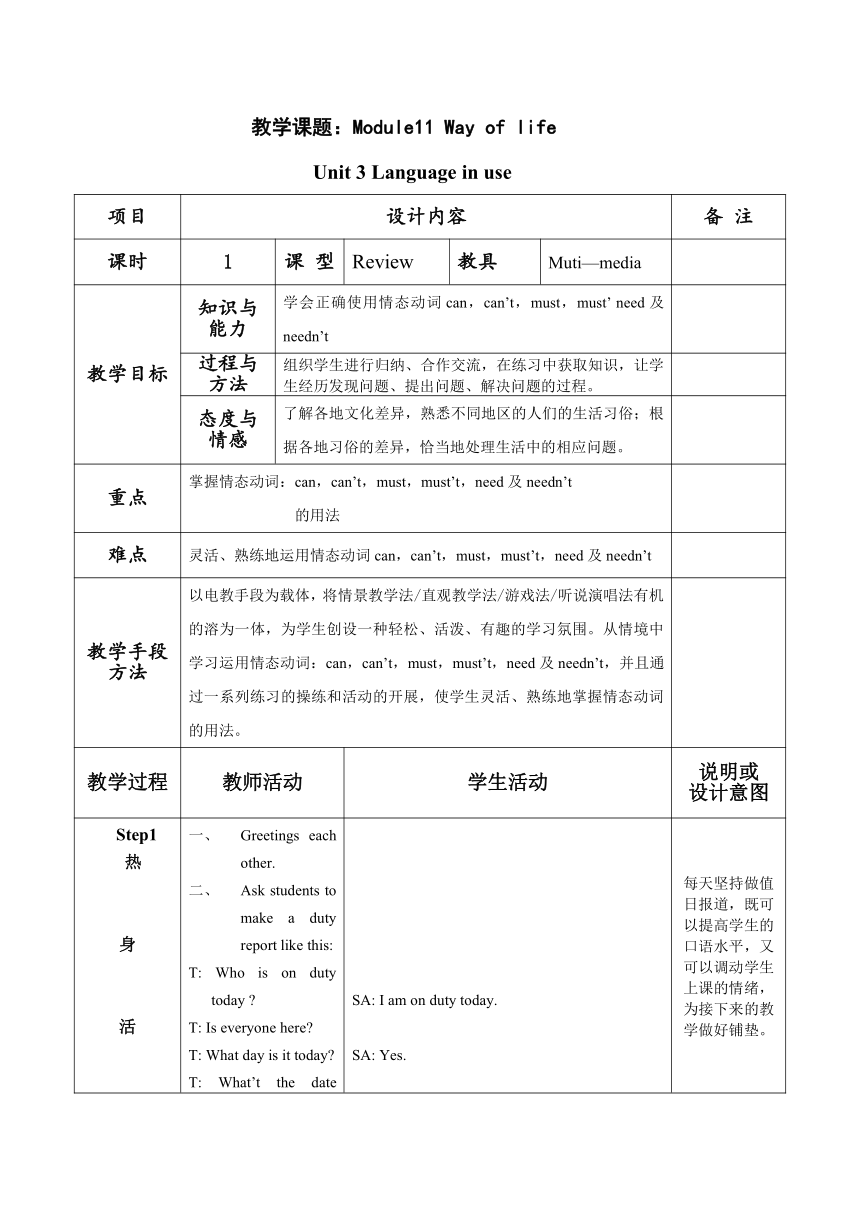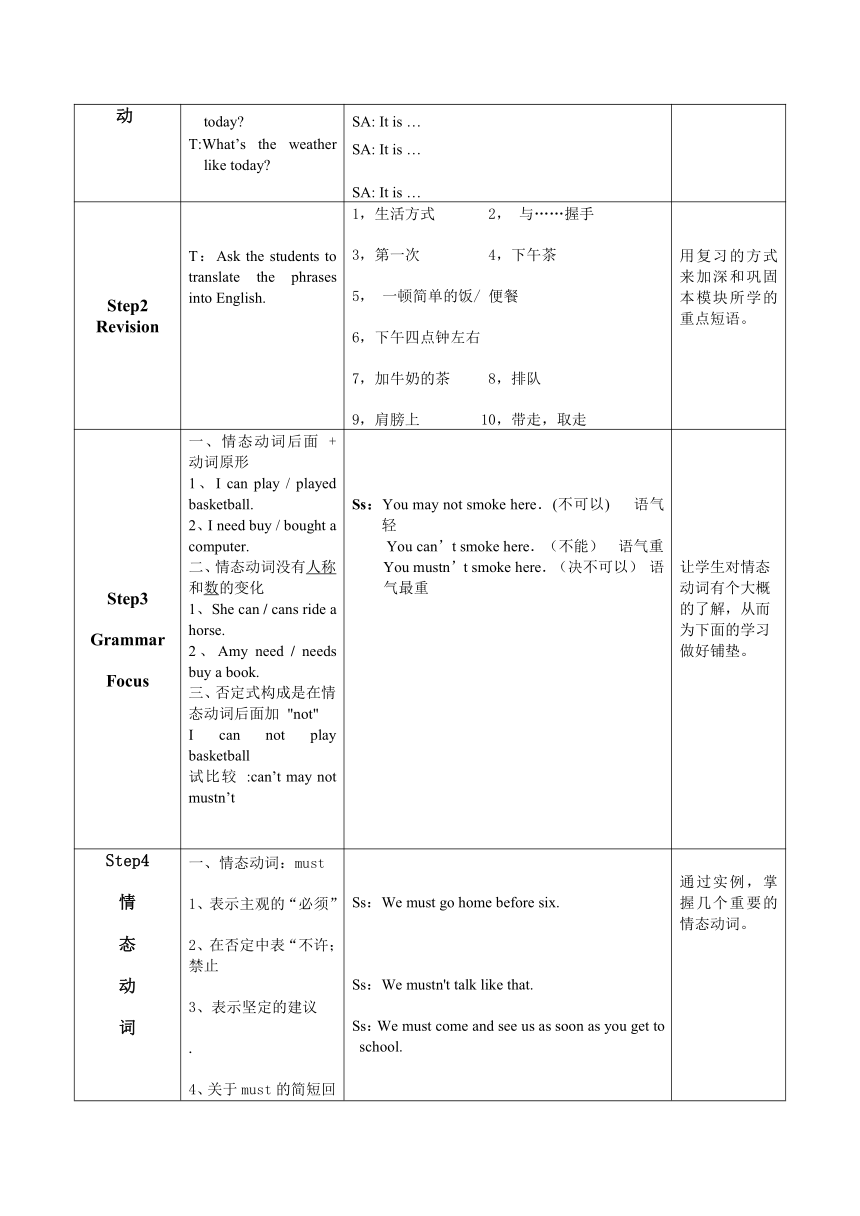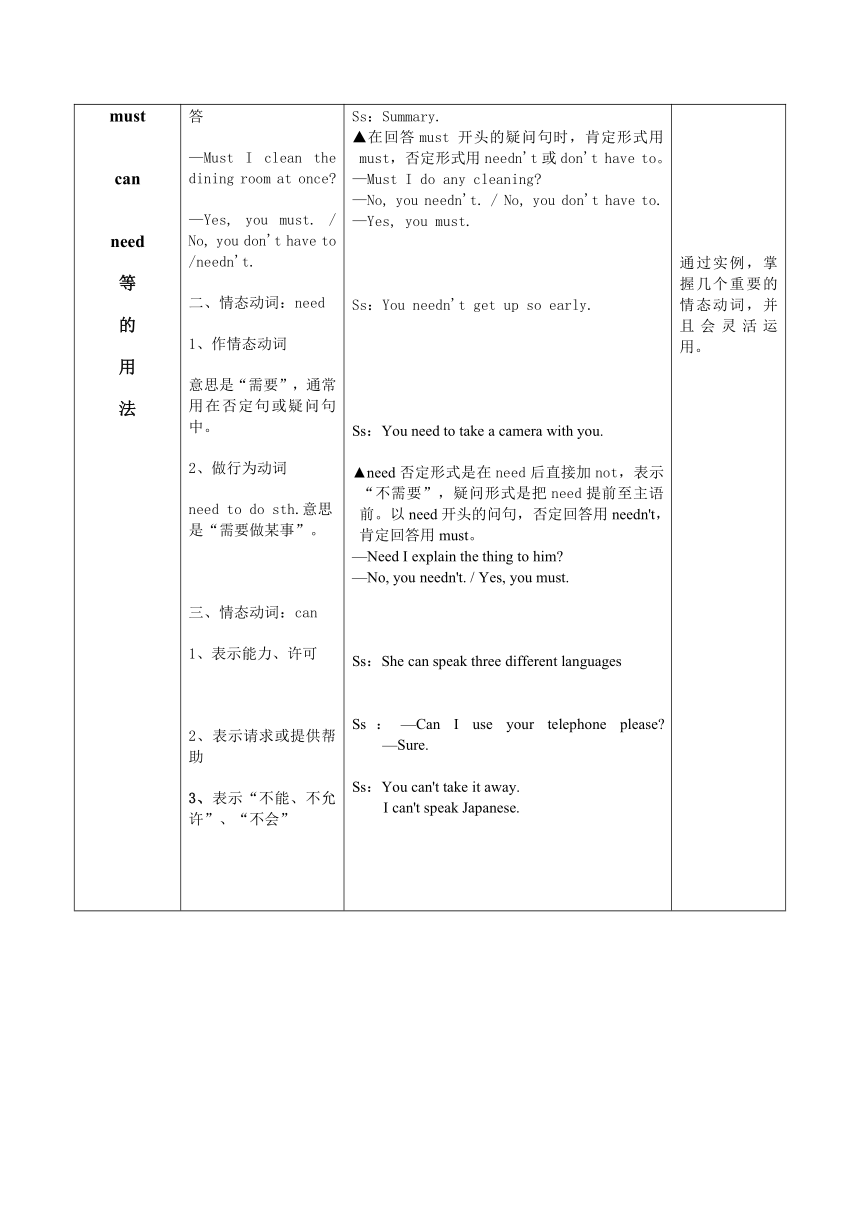外研版八年级上册教案Module 11 Way of life Unit 3 Language in use
文档属性
| 名称 | 外研版八年级上册教案Module 11 Way of life Unit 3 Language in use |  | |
| 格式 | zip | ||
| 文件大小 | 21.2KB | ||
| 资源类型 | 教案 | ||
| 版本资源 | 外研版 | ||
| 科目 | 英语 | ||
| 更新时间 | 2016-11-15 13:17:22 | ||
图片预览



文档简介
教学课题:Module11
Way
of
life
Unit
3
Language
in
use
项目
设计内容
备
注
课时
1
课
型
Review
教具
Muti—media
教学目标
知识与能力
学会正确使用情态动词can,can’t,must,must’
need及needn’t
过程与方法
组织学生进行归纳、合作交流,在练习中获取知识,让学生经历发现问题、提出问题、解决问题的过程。
态度与情感
了解各地文化差异,熟悉不同地区的人们的生活习俗;根据各地习俗的差异,恰当地处理生活中的相应问题。
重点
掌握情态动词:can,can’t,must,must’t,need及needn’t的用法
难点
灵活、熟练地运用情态动词can,can’t,must,must’t,need及needn’t
教学手段方法
以电教手段为载体,将情景教学法/直观教学法/游戏法/听说演唱法有机的溶为一体,为学生创设一种轻松、活泼、有趣的学习氛围。从情境中学习运用情态动词:can,can’t,must,must’t,need及needn’t,并且通过一系列练习的操练和活动的开展,使学生灵活、熟练地掌握情态动词的用法。
教学过程
教师活动
学生活动
说明或设计意图
Step1热身活动
Greetings
each
other.Ask
students
to
make
a
duty
report
like
this:T:
Who
is
on
duty
today
T:
Is
everyone
here T:
What
day
is
it
today T:
What’t
the
date
today T:What’s
the
weather
like
today
SA:
I
am
on
duty
today.
SA:
Yes.SA:
It
is
…SA:
It
is
…SA:
It
is
…
每天坚持做值日报道,既可以提高学生的口语水平,又可以调动学生上课的情绪,为接下来的教学做好铺垫。
Step2Revision
T:Ask
the
students
to
translate
the
phrases
into
English.
1,生活方式
2,
与……握手3,第一次
4,下午茶5,
一顿简单的饭/
便餐6,下午四点钟左右
7,加牛奶的茶
8,排队9,肩膀上
10,带走,取走
用复习的方式来加深和巩固本模块所学的重点短语。
Step3GrammarFocus
一、情态动词后面
+
动词原形1、I
can
play
/
played
basketball.
2、I
need
buy
/
bought
a
computer.二、情态动词没有人称和数的变化1、She
can
/
cans
ride
a
horse.2、Amy
need
/
needs
buy
a
book.三、否定式构成是在情态动词后面加
"not"
I
can
not
play
basketball试比较
:can’t
may
not
mustn’t
Ss:You
may
not
smoke
here.(不可以)
语气轻
You
can’t
smoke
here.(不能)
语气重
You
mustn’t
smoke
here.(决不可以)
语气最重
让学生对情态动词有个大概的了解,从而为下面的学习做好铺垫。
Step4情态动词mustcanneed等的用法
一、情态动词:must1、表示主观的“必须”2、在否定中表“不许;禁止3、表示坚定的建议.4、关于must的简短回答—Must
I
clean
the
dining
room
at
once —Yes,
you
must.
/
No,
you
don't
have
to
/needn't.二、情态动词:need1、作情态动词意思是“需要”,通常用在否定句或疑问句中。2、做行为动词need
to
do
sth.意思是“需要做某事”。三、情态动词:can1、表示能力、许可2、表示请求或提供帮助3、表示“不能、不允许”、“不会”
Ss:We
must
go
home
before
six.Ss:We
mustn't
talk
like
that.Ss:We
must
come
and
see
us
as
soon
as
you
get
to
school.Ss:Summary.▲在回答must
开头的疑问句时,肯定形式用must,否定形式用needn't或don't
have
to。—Must
I
do
any
cleaning —No,
you
needn't.
/
No,
you
don't
have
to.—Yes,
you
must.Ss:You
needn't
get
up
so
early.Ss:You
need
to
take
a
camera
with
you.▲need否定形式是在need后直接加not,表示“不需要”,疑问形式是把need提前至主语前。以need开头的问句,否定回答用needn't,肯定回答用must。—Need
I
explain
the
thing
to
him —No,
you
needn't.
/
Yes,
you
must.Ss:She
can
speak
three
different
languagesSs:—Can
I
use
your
telephone
please
—Sure.Ss:You
can't
take
it
away.
I
can't
speak
Japanese.
通过实例,掌握几个重要的情态动词。通过实例,掌握几个重要的情态动词,并且会灵活运用。
Step5情态动词练习操练
T:Ask
students
to
finish
some
exercises
of
the
usage
of
modal
verbs,and
check
the
answers.
1.
According
to
the
new
traffic
law,
everyone
in
a
car_____wear
the
seat
belt.
A.
can
B.
may
C.
must
D.
will2.
—______you
sing
an
English
song
—Yes,
I
can.
A.
Can
B.
May
C.
Must
D.
Need3.
—Must
I
go
to
medical
school
and
be
a
doctor
like
you,
Dad
—No,
you_____,
son.
You're
free
to
make
your
own
decision.
A.
can't
B.
mustn't
C.
shouldn't
D.
needn't4.
—What
do
you
want
to
eat
for
lunch
I
will
prepare
today.
—Honey,
you_____.
Let's
go
out
to
have
something
different.
A.
mustn't
B.
can't
C.
shouldn't
D.
don't
have
to5.
—_______I
swim
here
—I'm
sorry.
Children_____swim
alone
here.
A.
Must;
can't
B.
May;
must
C.
Can;
mustn't
D.
Can't;can6.
—_______I
do
the
laundry
first
—No,
you_____.
You
can
do
your
homework
first.
A.
Must;
mustn't
B.
Can;
mustn't
C.
Must;
needn't
D.
May;
needn't
通过一些练习,让学生操练,使其更好地掌握情态动词的用法。
Step6Activity1
T:
Ask
students
to
complete
the
conversations
with
can
or
can’t
S:认真完成练习。1
A:
Can
you
drive
a
car
at
the
age
of
seventeen
in
England
B:
Yes,
we
.
How
about
China
A:
No,
we
.2
A:
Can
you
open
a
gift
immediately
after
you
receive
it
in
England
B:
.What
about
China
A:
No,
we
usually
don’t.3
A:
Can
you
push
your
way
onto
a
bus
in
England
B:
___________
.How
about
China
A:
No,
we______either.4
A:
Can
you
drive
on
the
right-hand
side
of
the
road
in
England
B:
____________.What
about
China
A:
Yes,
we
must.
完成书本上关于情态动词的练习,让学生进行更多的操练,以便能更好地掌握。
Step7Activity2
T:Ask
students
to
complete
the
sentences
with
must
or
must
not.
School
rules1
You
be
late
for
school.2
You
eat
in
the
library.3
You
ride
your
bike
in
the
playground.4
You
do
your
homework.5
You
listen
to
the
teacher.
Step8Activity3
3.
Ask
students
to
underline
the
correct
words.
It
is
important
to
know
what
you
must
and
must
not
do
when
you
meet
people
from
a
different
country.You
may
/
must
not
ask
Westerners
“How
old
are
you ”
because
it
is
not
polite.
You
might
/
can
know
someone
well,
but
you
must
/
need
not
ask
“How
much
money
do
you
make ”
He
may
/
can
never
speak
to
you
again!In
public
places,
you
must
/
can
ask
people
before
you
take
photos
of
them,
and
you
must
not
/
might
not
eat
or
drink
in
shops
or
museums.
In
some
countries
you
cannot
/
can
go
into
someone’s
house
with
your
shoes
on.
You
need
not
/
must
not
take
them
off.
But
in
some
other
countries
you
might
/
must
not
wear
shoes
in
the
house.
Step9Activity4
T:Ask
students
to
listen
to
a
teenager
talking
about
his
life.
Check
(√)
the
things
he
must
or
mustn’t
do.▲clean
up,
把......打扫干净;把......收集整齐▲wash
up,
洗餐具▲wash
away,
冲走、冲垮▲stay
out
,待在外面
Ss:Listen
to
the
tape
carefully
and
then
check
(√)
the
things
he
must
or
mustn’t
do.must
must’t1
clean
up
bedroom
once
a
week
√2
wash
up
after
dinner
√3
stay
out
after
9
pm
√4
do
homework
before
√going
out5
wash
hands
before
dinner
√6
play
music
loudly
after
10
pm
√
不断地播放录音,训练学生的听力。
Step10Activity6
6.
Ask
students
to
write
some
things
you
can,
must
and
must
not
do
at
homeNow
work
in
pairs.
Tell
each
other
three
things
you
must
do
at
home
and
three
things
you
mustn’t
do.
Are
you
home
rules
different
or
the
same
Ss:e.g.
—I
must
visit
my
grandparents
once
a
week.
—I
must
wash
up
after
dinner.
—I
must
do
homework
before
going
out.—I
must’t
play
music
loudly
after
10
pm.
—I
mustn’t
stay
up
late
in
the
evening.
—
...
Step11SpellingBee
T:Now
I’ll
give
you
2
minutes
to
test
your
spelling.1.
English-Chinese
wash
up
stay
out
clean
up
wash
awayChinese-English一顿简单的饭/
便餐
下午四点钟左右
加牛奶的茶
排队肩膀上
带走,取走T:When
finished,
exchange
your
paper
to
see
who
does
the
best.T:教师下去巡视,给最先完成的同学发笑脸小奖品。
通过这个练习,测试学生的拼写能力
Step12Homework
1.Review
the
usage
of
modal
verbs
and
finish
the
exercise
paper.
2.
Can
you
make
a
summary
on
this
Module,
including
grammar,
new
words
and
expressions,
and
so
on.
Step13结束语
T:Goodbye
class!
Ss:Goodbye
teacher!
Step14板书设计
Module
11
Way
of
lifeUnit
3
Language
in
use一、情态动词后面
+
动词原形1.I
can
play
/
played
basketball.
2.I
need
buy
/
bought
a
computer.二、情态动词没有人称和数的变化1.She
can
/
cans
ride
a
horse.2.Amy
need
/
needs
buy
a
book.三、否定式构成是在情态动词后面加
"not"
I
can
not
play
basketball试比较
:can’t
may
not
mustn’t
Reflection
Way
of
life
Unit
3
Language
in
use
项目
设计内容
备
注
课时
1
课
型
Review
教具
Muti—media
教学目标
知识与能力
学会正确使用情态动词can,can’t,must,must’
need及needn’t
过程与方法
组织学生进行归纳、合作交流,在练习中获取知识,让学生经历发现问题、提出问题、解决问题的过程。
态度与情感
了解各地文化差异,熟悉不同地区的人们的生活习俗;根据各地习俗的差异,恰当地处理生活中的相应问题。
重点
掌握情态动词:can,can’t,must,must’t,need及needn’t的用法
难点
灵活、熟练地运用情态动词can,can’t,must,must’t,need及needn’t
教学手段方法
以电教手段为载体,将情景教学法/直观教学法/游戏法/听说演唱法有机的溶为一体,为学生创设一种轻松、活泼、有趣的学习氛围。从情境中学习运用情态动词:can,can’t,must,must’t,need及needn’t,并且通过一系列练习的操练和活动的开展,使学生灵活、熟练地掌握情态动词的用法。
教学过程
教师活动
学生活动
说明或设计意图
Step1热身活动
Greetings
each
other.Ask
students
to
make
a
duty
report
like
this:T:
Who
is
on
duty
today
T:
Is
everyone
here T:
What
day
is
it
today T:
What’t
the
date
today T:What’s
the
weather
like
today
SA:
I
am
on
duty
today.
SA:
Yes.SA:
It
is
…SA:
It
is
…SA:
It
is
…
每天坚持做值日报道,既可以提高学生的口语水平,又可以调动学生上课的情绪,为接下来的教学做好铺垫。
Step2Revision
T:Ask
the
students
to
translate
the
phrases
into
English.
1,生活方式
2,
与……握手3,第一次
4,下午茶5,
一顿简单的饭/
便餐6,下午四点钟左右
7,加牛奶的茶
8,排队9,肩膀上
10,带走,取走
用复习的方式来加深和巩固本模块所学的重点短语。
Step3GrammarFocus
一、情态动词后面
+
动词原形1、I
can
play
/
played
basketball.
2、I
need
buy
/
bought
a
computer.二、情态动词没有人称和数的变化1、She
can
/
cans
ride
a
horse.2、Amy
need
/
needs
buy
a
book.三、否定式构成是在情态动词后面加
"not"
I
can
not
play
basketball试比较
:can’t
may
not
mustn’t
Ss:You
may
not
smoke
here.(不可以)
语气轻
You
can’t
smoke
here.(不能)
语气重
You
mustn’t
smoke
here.(决不可以)
语气最重
让学生对情态动词有个大概的了解,从而为下面的学习做好铺垫。
Step4情态动词mustcanneed等的用法
一、情态动词:must1、表示主观的“必须”2、在否定中表“不许;禁止3、表示坚定的建议.4、关于must的简短回答—Must
I
clean
the
dining
room
at
once —Yes,
you
must.
/
No,
you
don't
have
to
/needn't.二、情态动词:need1、作情态动词意思是“需要”,通常用在否定句或疑问句中。2、做行为动词need
to
do
sth.意思是“需要做某事”。三、情态动词:can1、表示能力、许可2、表示请求或提供帮助3、表示“不能、不允许”、“不会”
Ss:We
must
go
home
before
six.Ss:We
mustn't
talk
like
that.Ss:We
must
come
and
see
us
as
soon
as
you
get
to
school.Ss:Summary.▲在回答must
开头的疑问句时,肯定形式用must,否定形式用needn't或don't
have
to。—Must
I
do
any
cleaning —No,
you
needn't.
/
No,
you
don't
have
to.—Yes,
you
must.Ss:You
needn't
get
up
so
early.Ss:You
need
to
take
a
camera
with
you.▲need否定形式是在need后直接加not,表示“不需要”,疑问形式是把need提前至主语前。以need开头的问句,否定回答用needn't,肯定回答用must。—Need
I
explain
the
thing
to
him —No,
you
needn't.
/
Yes,
you
must.Ss:She
can
speak
three
different
languagesSs:—Can
I
use
your
telephone
please
—Sure.Ss:You
can't
take
it
away.
I
can't
speak
Japanese.
通过实例,掌握几个重要的情态动词。通过实例,掌握几个重要的情态动词,并且会灵活运用。
Step5情态动词练习操练
T:Ask
students
to
finish
some
exercises
of
the
usage
of
modal
verbs,and
check
the
answers.
1.
According
to
the
new
traffic
law,
everyone
in
a
car_____wear
the
seat
belt.
A.
can
B.
may
C.
must
D.
will2.
—______you
sing
an
English
song
—Yes,
I
can.
A.
Can
B.
May
C.
Must
D.
Need3.
—Must
I
go
to
medical
school
and
be
a
doctor
like
you,
Dad
—No,
you_____,
son.
You're
free
to
make
your
own
decision.
A.
can't
B.
mustn't
C.
shouldn't
D.
needn't4.
—What
do
you
want
to
eat
for
lunch
I
will
prepare
today.
—Honey,
you_____.
Let's
go
out
to
have
something
different.
A.
mustn't
B.
can't
C.
shouldn't
D.
don't
have
to5.
—_______I
swim
here
—I'm
sorry.
Children_____swim
alone
here.
A.
Must;
can't
B.
May;
must
C.
Can;
mustn't
D.
Can't;can6.
—_______I
do
the
laundry
first
—No,
you_____.
You
can
do
your
homework
first.
A.
Must;
mustn't
B.
Can;
mustn't
C.
Must;
needn't
D.
May;
needn't
通过一些练习,让学生操练,使其更好地掌握情态动词的用法。
Step6Activity1
T:
Ask
students
to
complete
the
conversations
with
can
or
can’t
S:认真完成练习。1
A:
Can
you
drive
a
car
at
the
age
of
seventeen
in
England
B:
Yes,
we
.
How
about
China
A:
No,
we
.2
A:
Can
you
open
a
gift
immediately
after
you
receive
it
in
England
B:
.What
about
China
A:
No,
we
usually
don’t.3
A:
Can
you
push
your
way
onto
a
bus
in
England
B:
___________
.How
about
China
A:
No,
we______either.4
A:
Can
you
drive
on
the
right-hand
side
of
the
road
in
England
B:
____________.What
about
China
A:
Yes,
we
must.
完成书本上关于情态动词的练习,让学生进行更多的操练,以便能更好地掌握。
Step7Activity2
T:Ask
students
to
complete
the
sentences
with
must
or
must
not.
School
rules1
You
be
late
for
school.2
You
eat
in
the
library.3
You
ride
your
bike
in
the
playground.4
You
do
your
homework.5
You
listen
to
the
teacher.
Step8Activity3
3.
Ask
students
to
underline
the
correct
words.
It
is
important
to
know
what
you
must
and
must
not
do
when
you
meet
people
from
a
different
country.You
may
/
must
not
ask
Westerners
“How
old
are
you ”
because
it
is
not
polite.
You
might
/
can
know
someone
well,
but
you
must
/
need
not
ask
“How
much
money
do
you
make ”
He
may
/
can
never
speak
to
you
again!In
public
places,
you
must
/
can
ask
people
before
you
take
photos
of
them,
and
you
must
not
/
might
not
eat
or
drink
in
shops
or
museums.
In
some
countries
you
cannot
/
can
go
into
someone’s
house
with
your
shoes
on.
You
need
not
/
must
not
take
them
off.
But
in
some
other
countries
you
might
/
must
not
wear
shoes
in
the
house.
Step9Activity4
T:Ask
students
to
listen
to
a
teenager
talking
about
his
life.
Check
(√)
the
things
he
must
or
mustn’t
do.▲clean
up,
把......打扫干净;把......收集整齐▲wash
up,
洗餐具▲wash
away,
冲走、冲垮▲stay
out
,待在外面
Ss:Listen
to
the
tape
carefully
and
then
check
(√)
the
things
he
must
or
mustn’t
do.must
must’t1
clean
up
bedroom
once
a
week
√2
wash
up
after
dinner
√3
stay
out
after
9
pm
√4
do
homework
before
√going
out5
wash
hands
before
dinner
√6
play
music
loudly
after
10
pm
√
不断地播放录音,训练学生的听力。
Step10Activity6
6.
Ask
students
to
write
some
things
you
can,
must
and
must
not
do
at
homeNow
work
in
pairs.
Tell
each
other
three
things
you
must
do
at
home
and
three
things
you
mustn’t
do.
Are
you
home
rules
different
or
the
same
Ss:e.g.
—I
must
visit
my
grandparents
once
a
week.
—I
must
wash
up
after
dinner.
—I
must
do
homework
before
going
out.—I
must’t
play
music
loudly
after
10
pm.
—I
mustn’t
stay
up
late
in
the
evening.
—
...
Step11SpellingBee
T:Now
I’ll
give
you
2
minutes
to
test
your
spelling.1.
English-Chinese
wash
up
stay
out
clean
up
wash
awayChinese-English一顿简单的饭/
便餐
下午四点钟左右
加牛奶的茶
排队肩膀上
带走,取走T:When
finished,
exchange
your
paper
to
see
who
does
the
best.T:教师下去巡视,给最先完成的同学发笑脸小奖品。
通过这个练习,测试学生的拼写能力
Step12Homework
1.Review
the
usage
of
modal
verbs
and
finish
the
exercise
paper.
2.
Can
you
make
a
summary
on
this
Module,
including
grammar,
new
words
and
expressions,
and
so
on.
Step13结束语
T:Goodbye
class!
Ss:Goodbye
teacher!
Step14板书设计
Module
11
Way
of
lifeUnit
3
Language
in
use一、情态动词后面
+
动词原形1.I
can
play
/
played
basketball.
2.I
need
buy
/
bought
a
computer.二、情态动词没有人称和数的变化1.She
can
/
cans
ride
a
horse.2.Amy
need
/
needs
buy
a
book.三、否定式构成是在情态动词后面加
"not"
I
can
not
play
basketball试比较
:can’t
may
not
mustn’t
Reflection
同课章节目录
- Module 1 How to learn English
- Unit 1 Let's try to speak English as much as possi
- Unit 2 You should smile at her.
- Unit 3 Language in use .
- Module 2 My home town and my country
- Unit 1 It's taller than many other buildings.
- Unit 2 Cambridge is a beautiful city in the east o
- Unit 3 Language in use .
- Module 3 Sports.
- Unit 1 Nothing is more exciting than playing tenni
- Unit 2 This year we training more carefully.
- Unit 3 Language in use .
- Module 4 Planes, ships and trains .
- Unit 1 He lives the farthest from school.
- Unit 2 What is the best way to travel.
- Unit 3 Language in use .
- Module 5 Lao She Teahouse.
- Unit 1 I wanted to see the Beijing Opera.
- Unit 2 It descibes the changes in Chinese society.
- Unit 3 Language in use .
- Module 6 Animals in danger.
- Unit 1 It allows people to get closer to them .
- Unit 2 The WWF is working hard to save them all.
- Unit 3 Language in use .
- Revision module A
- Module 7 A famous story
- Unit 1 Alice was sitting with her sister by the ri
- Unit 2 She was thinking about her cat.
- Unit 3 Language in use .
- Module 8 Accidents
- Unit 1 While the car were changing to red, a car s
- Unit 2 I was trying to pick it up when it bite me
- Unit 3 Language in use .
- Module 9 Population
- Unit 1 The population of China is about 1.37 billi
- Unit 2 Arnwick was a city with 200,000 people.
- Unit 3 Language in use .
- Module 10 The weathe
- Unit 1 It might snow.
- Unit 2 The weather is fine all year round.
- Unit 3 Language in use .
- Module 11 Way of life
- Unit 1 In China ,we open a gift later.
- Unit 2 In England, you usually drink tea with milk
- Unit 3 Language in use .
- Module 12 Help
- Unit 1 What should we do before help arrives?
- Unit 2 Stay away from windows and heavy furniture.
- Unit 3 Language in use .
- Revision module B
